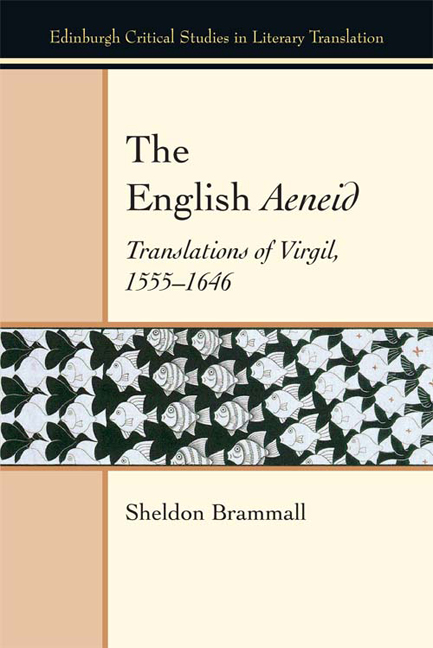Book contents
- Frontmatter
- Contents
- Series Editors’ Preface
- Acknowledgements
- Notes on the Text
- Introduction
- 1 The Search for a Lofty British Virgil: The Early Elizabethan Aeneids of Thomas Phaer, Thomas Twyne and Richard Stanyhurst
- 2 ‘Sound this Angry Message in Thine Eares’: Sympathy and the Translations of the Aeneid in Marlowe's Dido Queene of Carthage
- 3 Courteous Virgil: The Manuscript Translations of an Anonymous Poet, Sir John Harington and Sir William Mure of Rowallan
- 4 Virginian Virgil: The Single-Book Translations of Sir Thomas Wroth, Sir Dudley Digges and George Sandys
- 5 Rome at War: The Military Virgils of John Vicars, Robert Stapylton and Robert Heath
- Conclusion
- Bibliography
- Index
1 - The Search for a Lofty British Virgil: The Early Elizabethan Aeneids of Thomas Phaer, Thomas Twyne and Richard Stanyhurst
Published online by Cambridge University Press: 12 September 2017
- Frontmatter
- Contents
- Series Editors’ Preface
- Acknowledgements
- Notes on the Text
- Introduction
- 1 The Search for a Lofty British Virgil: The Early Elizabethan Aeneids of Thomas Phaer, Thomas Twyne and Richard Stanyhurst
- 2 ‘Sound this Angry Message in Thine Eares’: Sympathy and the Translations of the Aeneid in Marlowe's Dido Queene of Carthage
- 3 Courteous Virgil: The Manuscript Translations of an Anonymous Poet, Sir John Harington and Sir William Mure of Rowallan
- 4 Virginian Virgil: The Single-Book Translations of Sir Thomas Wroth, Sir Dudley Digges and George Sandys
- 5 Rome at War: The Military Virgils of John Vicars, Robert Stapylton and Robert Heath
- Conclusion
- Bibliography
- Index
Summary
The English Renaissance Aeneid
The complete translation of the Aeneid by Thomas Phaer and Thomas Twyne has every reason to be considered the central English Renaissance Aeneid. The publication history tells the story succinctly. Whereas no other translation of Virgil was printed in England more than twice until the 1650s (and only the Earl of Surrey's translation of Book 4 was printed more than once in England during this time), the translation by Phaer and Twyne went through eight editions, running from 1558 through to 1620. It influenced the translations by Richard Stanyhurst (1582), Sir John Harington (1604) and Sir Thomas Wroth (1620), and it was still one of the most important subtexts for John Vicars’ The XII Aeneids of Virgil (1632). Much as the translation by Annibale Caro came to dominate the market for Virgil in Italian, the Phaer-Twyne Aeneid became the English standard. It was not until the eighteenth century that any English translation of Virgil's epic went through more editions.
That this translation would become so successful would have been difficult to predict from its inauspicious beginnings. The initial translator, Thomas Phaer, was a physician and solicitor in the Marches of Wales. He published nothing else in verse and would have made an unlikely candidate for a great interpreter of Virgil. Nevertheless, in 1555 he began work, hoping to be the first to ‘sette open’ the gate so that future translators could follow. Although Phaer seems to have been aware of both the Middle Scots translation by Gavin Douglas and the two books by the Earl of Surrey, he presented his version of the Aeneid as the start of a new line of translations. By December 1557, Phaer had completed a version of Books 1–7. He had these printed in 1558. By April 1560, he had completed up to the end of Book 9. But late in that spring, he suffered a riding accident that ruined his hand and would soon cost him his life. Before his death on 12 August, he sent all that he had finished of his translation – which was then up to line 286 of Book 10 – to William Wightman, a friend of his in Pembrokeshire. This friend fervently believed in Phaer's literary gifts and, after Phaer had passed away, he searched the deceased's house for any trace of remaining verses.
- Type
- Chapter
- Information
- The English AeneidTranslations of Virgil 1555-1646, pp. 19 - 54Publisher: Edinburgh University PressPrint publication year: 2015



